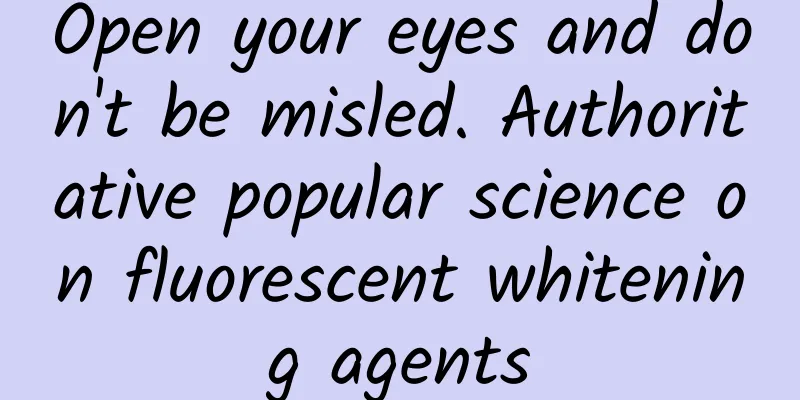Open your eyes and don't be misled. Authoritative popular science on fluorescent whitening agents

|
Fluorescent whitening agents are added to daily necessities, but they are often "criticized" by consumers, and the saying that "fluorescent whitening agents are harmful" often causes panic among consumers. In life and on the Internet, there are many different interpretations of fluorescent whitening agents. What exactly are fluorescent whitening agents? Will adding a moderate amount of fluorescent whitening agents to soap and other detergents cause harm to the human body? This article provides a detailed answer for everyone. Fluorescent substances are commonly found in nature. Fluorescent substances are commonly found in nature, such as the well-known fireflies and jellyfish. These animals and marine life can glow because they contain various fluorescent proteins in their bodies. Some fluorescent substances also exist in the human body, such as some amino acids, vitamins A, E, hormones, etc. Glowing = harmful is a myth! In fact, whether a substance emits light has no absolute correlation with whether it contains fluorescent agents or is toxic. The fluorescence phenomenon is just a pure physical phenomenon, without chemical reactions, and will not cause adverse effects on human health. Moreover, some nutrients in the human body also contain fluorescent components. Therefore, it is not scientific to test products simply by irradiating them with ultraviolet light. What is fluorescent brightener? According to the national standard GB/T6687-2006 "Terms of Dyes", fluorescent whitening agent is a colorless fluorescent dye that can excite blue and purple light under ultraviolet light, which complements the yellow light on the substrate and has a whitening effect. In layman's terms, fluorescent whitening agent uses the optical complementary color effect to whiten, brighten or enhance the color of white or light-colored items (such as soap, detergent, textiles, plastics, paper, etc.). It does not react chemically with the object, but relies on optical effects to increase the whiteness of the object and uses fluorescence to increase the visual sense of whiteness. Therefore, fluorescent whitening agent is also called "optical brightener" or "white fluorescent dye". Safety of adding fluorescent whitening agents to soap Since the 1950s and 1960s, foreign countries have begun to conduct research on the safety of fluorescent whitening agents. Toxicologists from many countries and independent organizations and research institutions such as the European Chemical Industry Association, the European Soap Detergent Association, the Japanese National Health Testing Agency, and the Japanese Soap Detergent Association have conducted comprehensive and in-depth research and published reports. The results show that fluorescent whitening agents have no skin sensitization, phototoxicity, oral toxicity, percutaneous toxicity, reproductive toxicity, mutagenicity, and carcinogenicity. The experimental conclusions on the safety of fluorescent whitening agents are supported by detailed test methods, a large amount of experimental data, and result evaluation methods. At present, my country's industry standard for fluorescent whitening agents for detergents, "Fluorescent Whitening Agents for Detergents" (QB/T2953-2008), has just been revised and will be officially implemented on November 1, 2023. "It stipulates the terms and definitions, product classification, requirements, test methods, inspection rules and markings, packaging, transportation and storage of fluorescent whitening agents for detergents. This standard applies to fluorescent whitening agents added to the formula of detergents for various fabrics." As early as August 2011, the China Detergent Industry Association held an "Expert Media Meeting on the Safety of Fluorescent Brighteners in Detergents" in Beijing, and relevant authoritative experts also concluded: "Clothing detergents containing fluorescent brighteners are safe for humans and the environment." The former Ministry of Chemical Industry's Pesticide Safety Evaluation Supervision and Inspection Center also conducted toxicity experiments on the fluorescent brightener CBS-X (belonging to the distyryl biphenyl class), and the results confirmed that at a given dose, the fluorescent brightener is low in toxicity and non-irritating. Adding fluorescent agent can improve the whiteness of washing powder or soap, improve the appearance of detergent products, and enhance the product grade. The human safety of fluorescent whitening agents contained in such soaps, laundry detergents and other products has been rigorously demonstrated and can be used with confidence. Looking at the rational use of fluorescent whitening agents In summary, as a consumer, you should rationally choose regular products and do not be afraid of fluorescent whitening agents. Therefore, if you detect fluorescence with a purple light flashlight in your daily life, you do not need to panic. As long as the regular products are purchased through regular channels, you can use them with confidence. The fluorescent brighteners added to the regular and qualified soaps, laundry detergents and other washing products we use in daily life have no negative effects on the human body. In fact, not only fluorescent brighteners, but all product additives that meet national standards are within the safe range. I hope that consumers will not believe in rumors, whether it is daily necessities or food, pay attention to avoid buying irregular three-no products. Source: China Detergent Industry Association |
Recommend
My legs hurt so much during my period
Girls will have many adverse symptoms when they h...
Here's what you want to know about nucleic acid testing
Recently, many places have organized residents to...
Why does it hurt to touch my nipples?
If your nipples feel painful when they are touche...
What are the dangers of papilloma-positive
In the treatment of diseases, the choice of metho...
What are the benefits and effects of crucian carp soup? Does crucian carp soup contain protein?
Fish is very nutritious, and its therapeutic effe...
Picosecond pregnancy spot removal
In daily life, many women are troubled by freckle...
A complete picture of a woman's right hand with a mole
Complete collection of illustrations of moles on ...
What is the root cause of wrinkles at the corners of the mouth? How to remove wrinkles at the corners of the mouth
Time flies, and before you can look back, wrinkle...
Which is better, Fuke Qianjin Tablets or Fuke Qianjin Capsules?
The quality of Fuke Qianjin Tablets is stable, th...
What should I pay attention to when I am nine months pregnant?
For a woman, becoming a mother after nine months ...
How long to take oxygen during pregnancy
During pregnancy, many pregnant women always feel...
What should I pay attention to after the due date?
We all know that the due date is a common estimat...
I don't have breast pain before my period. I'm pregnant.
Does breast pain before menstruation mean I’m pre...
Why do girls have hair around their nipples?
Nowadays, women are very concerned about whether ...









